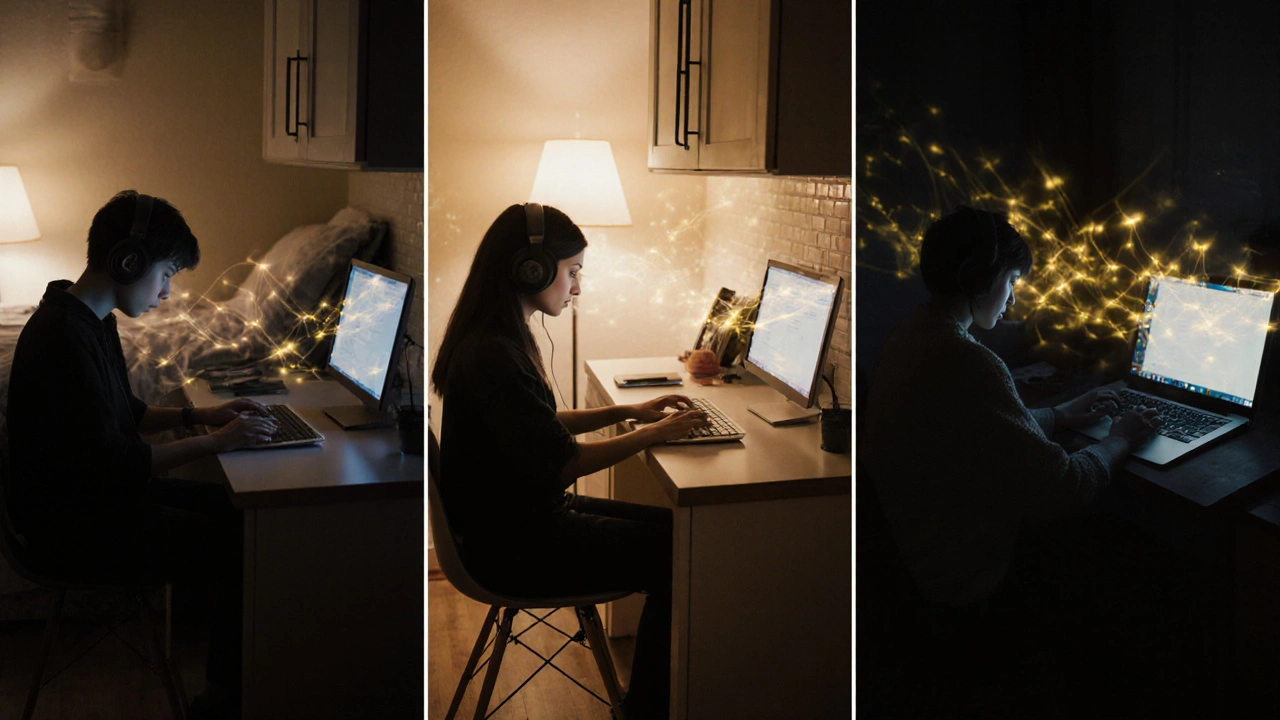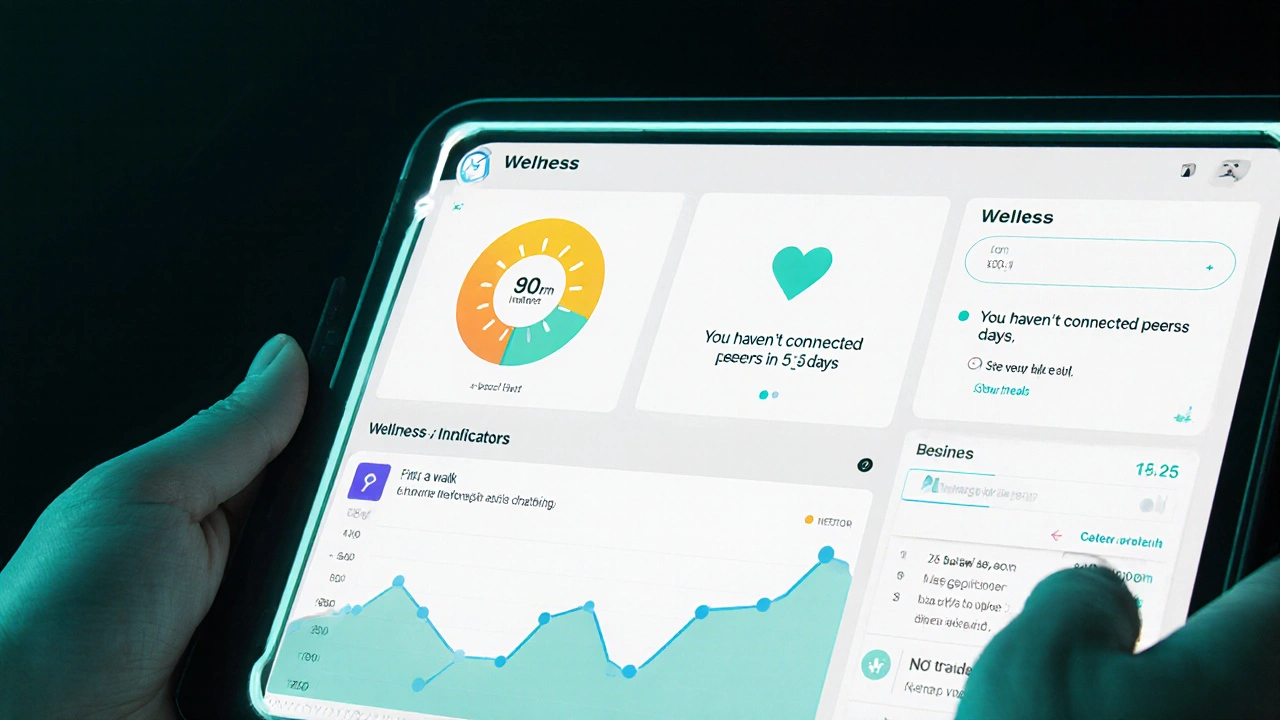More than 60% of university students in New Zealand, the U.S., and the U.K. now take at least one course online. But while course platforms have gotten faster and more interactive, something’s been left behind: mental health. The quiet stress of staring at a screen for hours, the isolation of no campus buzz, the guilt of falling behind when no one’s watching - these aren’t just "bad days." They’re systemic issues in online learning.
Why Online Learning Feels So Heavy
It’s not just about screen time. It’s about the loss of structure. In a physical classroom, you walk to class, sit with peers, hear a professor’s voice, feel the energy of a room. Online? You open your laptop in pajamas at 10 a.m., mute your mic, and hope no one notices you’re not paying attention. No one checks in. No one asks if you’re okay.
Research from the University of Auckland in early 2025 found that students in fully online programs reported 42% higher levels of chronic fatigue than those in hybrid setups. The reason? No transition rituals. No commute to mentally shift from home to school. No post-class coffee with classmates to decompress. Your brain never gets a signal that class is over.
And then there’s the comparison trap. Social media feeds are full of polished study routines, perfect Zoom backgrounds, and "I aced this online exam" posts. Meanwhile, you’re scrolling at 2 a.m. with half-finished assignments and a cold cup of coffee. You start thinking you’re the only one struggling. You’re not.
What Happens When Mental Health Is Ignored
When students don’t get support, outcomes suffer. Dropout rates in fully online degree programs jumped 18% between 2022 and 2024, according to a global study of 120,000 learners. The biggest trigger? Not failed exams. Not hard material. It was emotional exhaustion.
One student from Wellington, 21, told a campus mental health team: "I didn’t miss a single deadline. I got As. But I cried every night because I felt like a ghost in my own education. No one saw me trying. No one asked if I was sleeping."
That’s the hidden cost. Institutions focus on engagement metrics - login rates, video views, quiz scores. But they don’t track loneliness, anxiety spikes, or sleep patterns. And without data, they don’t act.
What Works: Real Solutions Already in Use
Some schools are fixing this - not with expensive apps, but with simple, human changes.
- Weekly check-in videos: At Massey University, every online student gets a 5-minute video prompt from their tutor every Monday: "How are you really doing this week?" No grades. No judgment. Just space to say "I’m overwhelmed" or "I’m fine." Response rates jumped to 78% - and students who used it were 30% less likely to drop out.
- Virtual "study cafes": Instead of forcing Zoom meetings, some courses host asynchronous audio rooms. You join, turn on your mic, and work silently with others. No talking required. Just the sound of typing, page turns, and quiet breathing. It mimics the feeling of a library. Students call it "the quietest form of company."
- Flexible deadlines with no penalty: A pilot at the University of Otago let students request a 72-hour extension on any assignment - no explanation needed. Usage was low (only 12% of students asked), but those who did reported feeling more in control. The real win? Fewer panic emails and crisis calls to counselors.

The Role of Technology - and Where It Falls Short
There are dozens of mental health apps marketed to students: mood trackers, meditation bots, AI chatbots that "listen." But most are designed like consumer products - flashy, gamified, and disconnected from the learning environment.
One study from Stanford in 2024 tested three popular wellness apps with 2,000 online learners. Results? Only 11% used them more than twice. Why? They felt like chores. "I already have five apps I’m supposed to use for school," said one student. "I don’t need another one telling me to breathe."
The real opportunity? Embed wellness into the learning platform itself. Imagine a dashboard that shows not just your grades, but your activity patterns: "You’ve been online 14 hours this week - take a walk." Or a feature that says, "You haven’t interacted with peers in 5 days - here’s a quiet study group starting in 10 minutes."
That’s not science fiction. It’s already being built by EdTech startups in Canada and Australia. The key? It’s not about tracking you. It’s about reminding you - gently, without shame.
What Students Can Do Right Now
You don’t need your school to fix everything. Here’s what actually helps, based on feedback from 500 online learners:
- Create a morning ritual: Even 10 minutes of sunlight, stretching, or making tea before logging in sets a tone. It tells your brain: "This is my time. I’m here to learn, not just survive."
- Set physical boundaries: Don’t study in bed. Don’t work on the couch where you watch Netflix. Designate one chair, one corner. Your brain needs cues.
- Use the "two-minute rule" for social connection: If you think of someone - a classmate, a tutor - send a quick text: "Hey, how’s your week going?" No pressure to reply. Just a tiny thread of human contact.
- Track your energy, not just your tasks: Instead of a to-do list, keep an energy log. "9 a.m. - felt sharp. 2 p.m. - brain fog. 7 p.m. - drained." Patterns reveal when you’re most vulnerable.
- Ask for help before you break: Most schools offer free counseling. But you have to click the button. Don’t wait until you’re crying in the bathroom at 3 a.m. Book a session when you’re just feeling off. Prevention beats crisis.

The Future Is Human-Centered
Online learning isn’t going away. But the future of it won’t be defined by faster video streaming or AI tutors. It’ll be defined by how well it supports the people using it.
The most successful programs in 2025 aren’t the ones with the most features. They’re the ones where students say, "I felt seen."
That means designing for silence as much as for interaction. For rest as much as for productivity. For the messy, real, tired human being behind the screen - not just the idealized learner in the brochure.
If you’re an educator, ask: "What’s one small thing I can do this week to remind my students they’re not alone?" If you’re a student, ask yourself: "What’s one thing I can do to protect my peace?" The answer doesn’t need to be big. It just needs to be real.
Is online learning worse for mental health than in-person classes?
It’s not inherently worse - but it’s riskier if not designed well. In-person classes offer natural social cues, movement, and structure that online environments often lack. Without intentional support, online learners are more likely to feel isolated, overwhelmed, or disconnected. The difference isn’t the format - it’s the care built into it.
Can mental health apps really help online students?
Most commercial apps don’t. They’re designed for general users, not learners juggling deadlines, isolation, and self-doubt. The few that work are the ones embedded into learning platforms - like a gentle nudge to take a break after 90 minutes of screen time, or a prompt to join a quiet study room. Tools that feel like obligations fail. Tools that feel like support stick.
How do I know if I’m just stressed or actually struggling with my mental health?
Stress is temporary. It goes away after a good night’s sleep or finishing a big assignment. Mental health struggles last. If you’ve felt hopeless, exhausted, or disconnected for more than two weeks - even when things are going "okay" - that’s a sign. It’s not weakness. It’s your body asking for help. Talking to a counselor doesn’t mean you’re broken. It means you’re paying attention.
What should I do if my school doesn’t offer mental health support for online students?
Start small. Connect with one classmate. Join a public online study group (Reddit, Discord, or even a Facebook group). Use free resources like the Mental Health Foundation or Crisis Text Line. Then, write to your program director. Share your experience. Ask: "What’s being done to support student well-being?" One voice can spark change. You’re not asking for special treatment - you’re asking for basic humanity.
Are there any free tools or resources I can use right now?
Yes. The Mental Health Foundation (New Zealand) offers free downloadable guides on managing online learning stress. The Calm app has a free 7-day trial for mindfulness exercises. Headspace offers a free "Student Pack" for verified learners. And if you’re in the U.S., Canada, or the U.K., Crisis Text Line (text HOME to 741741) is available 24/7. You don’t need insurance. You don’t need an appointment. Just a phone.
Next Steps: What to Try This Week
If you’re an online learner, pick one thing from the list above - one ritual, one check-in, one boundary - and try it for seven days. Write down how you feel. Not whether you "succeeded." Just how you felt.
If you’re an instructor or administrator, talk to three students this week. Not about grades. Not about assignments. Ask: "What’s one thing that makes online learning harder than it should be?" Listen. Don’t fix. Just listen.
Wellness isn’t a feature. It’s the foundation. And right now, too many online learning systems are built on sand.


Comments
Kendall Storey
Let’s be real-online learning is just capitalism’s way of outsourcing emotional labor to students. No campus, no structure, no human contact, but still expecting you to perform like a well-oiled machine. The ‘study cafes’ idea? Genius. It’s not about productivity-it’s about creating a digital sense of presence. We need more of that, not another app that tracks your breathing like you’re a robot on a factory line.
Ashton Strong
It is imperative to recognize that the absence of institutionalized mental health infrastructure within digital learning environments constitutes a profound systemic failure. The empirical data presented herein-particularly the 42% increase in chronic fatigue among fully online students-demands immediate pedagogical recalibration. Institutions must prioritize affective support mechanisms with the same rigor as academic outcomes.
Steven Hanton
I’ve been teaching online for five years, and I’ve seen students burn out quietly-no drama, just silence. The weekly check-in videos? That’s the kind of low-effort, high-impact thing that makes a difference. You don’t need fancy tech. You just need to say, ‘I see you.’ It’s not about fixing everything. It’s about not pretending everything’s fine when it’s not.
Pamela Tanner
There is a critical distinction between stress and sustained emotional exhaustion. Stress is situational; mental health deterioration is systemic. If a student is crying every night despite earning As, that is not a personal failing-it is a design flaw in the educational ecosystem. We must stop pathologizing the symptoms and start auditing the architecture.
Kristina Kalolo
Interesting data. I wonder how many of these students had prior mental health conditions before going fully online. Could be selection bias.
ravi kumar
From India, I can say this hits hard. We don’t have counseling in most online programs here. But I started joining silent study streams on Discord. Just the sound of typing-it’s like having someone beside you. Not talking. Just being there. Small thing. Helps more than you think.
Megan Blakeman
OMG YES. I did the two-minute rule and texted my classmate who I barely know and she wrote back with ‘same’ and we just both sat in our rooms feeling less alone. It’s not about deep conversations-it’s about tiny anchors. I’m crying typing this because I didn’t realize how much I needed that.
Akhil Bellam
Pathetic. You’re telling me students can’t handle a little isolation? Back in my day, we walked five miles uphill both ways to class-with no Wi-Fi, no Zoom, no therapy apps-and we still graduated. This generation is soft. They need to toughen up. Stop coddling them with ‘quiet study rooms’ and ‘no-questions-asked extensions.’ Real life doesn’t give you 72-hour grace periods.
Amber Swartz
Okay but have you seen the comments section of any university’s online course? It’s a graveyard. People are just… gone. I had a classmate who stopped posting. No one noticed. Not even the prof. Then one day she just… disappeared. No goodbye. No explanation. I still think about her. What if she didn’t just drop out? What if she just… faded?
Robert Byrne
You people are acting like this is new. It’s not. This has been happening since 2020. And now you’re surprised? The system was designed to exploit students, not support them. Stop romanticizing ‘small gestures.’ Demand structural change. Fund counselors. Reduce course loads. End the myth that ‘more engagement = better learning.’ Your brain isn’t a click tracker.
Tia Muzdalifah
so i started making tea before i log in and honestly? it’s changed everything. i used to just roll outta bed and open my laptop like a zombie. now i have 10 mins of quiet, sun on my face, tea in my hands. my brain finally knows it’s time to be a student, not just a ghost. also i texted my prof once just to say ‘hey, hope you’re ok’ and she replied with a heart emoji. i cried. in a good way.
Zoe Hill
I tried the energy log instead of a to-do list and holy cow it’s been a game changer. I thought I was just lazy, but turns out I’m just drained after 2pm. Now I schedule my hardest work for 9-11am and take naps after lunch. No guilt. Just science. Also I’m not perfect-I still forget to drink water-but I’m trying. And that’s enough.
Christina Kooiman
It is, however, of paramount importance to underscore the fact that the notion of ‘quiet study rooms’ as a viable solution to the systemic collapse of student mental well-being is not only reductive-it is dangerously misleading. The absence of institutional accountability, the normalization of emotional neglect, and the commodification of education under the guise of ‘flexibility’ cannot be remedied by ambient typing sounds or 5-minute video prompts. This is not a behavioral issue; it is a moral one. We are not failing students because they lack discipline-we are failing them because we have stopped caring enough to fund real support. And if you’re telling me that a student needs to ‘create a morning ritual’ to survive an educational system that was never designed for human beings, then we have already lost.